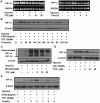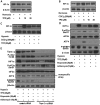Suppression of hypoxia-inducible factor 1α (HIF-1α) by tirapazamine is dependent on eIF2α phosphorylation rather than the mTORC1/4E-BP1 pathway
- PMID: 21085474
- PMCID: PMC2976688
- DOI: 10.1371/journal.pone.0013910
Suppression of hypoxia-inducible factor 1α (HIF-1α) by tirapazamine is dependent on eIF2α phosphorylation rather than the mTORC1/4E-BP1 pathway
Abstract
Hypoxia-inducible factor 1 (HIF-1), a heterodimeric transcription factor that mediates the adaptation of tumor cells and tissues to the hypoxic microenvironment, has attracted considerable interest as a potential therapeutic target. Tirapazamine (TPZ), a well-characterized bioreductive anticancer agent, is currently in Phase II and III clinical trials. A major aspect of the anticancer activity of TPZ is its identity as a tumor-specific topoisomerase IIα inhibitor. In the study, for the first time, we found that TPZ acts in a novel manner to inhibit HIF-1α accumulation driven by hypoxia or growth factors in human cancer cells and in HepG2 cell-derived tumors in athymic nude mice. We investigated the mechanism of TPZ on HIF-1α in HeLa human cervical cancer cells by western blot analysis, reverse transcription-PCR assay, luciferase reporter assay and small interfering RNA (siRNA) assay. Mechanistic studies demonstrated that neither HIF-1α mRNA levels nor HIF-1α protein degradation are affected by TPZ. However, TPZ was found to be involved in HIF-1α translational regulation. Further studies revealed that the inhibitory effect of TPZ on HIF-1α protein synthesis is dependent on the phosphorylation of translation initiation factor 2α (eIF2α) rather than the mTOR complex 1/eukaryotic initiation factor 4E-binding protein-1 (mTORC1/4E-BP1) pathway. Immunofluorescence analysis of tumor sections provide the in vivo evidences to support our hypothesis. Additionally, siRNA specifically targeting topoisomerase IIα did not reverse the ability of TPZ to inhibit HIF-1α expression, suggesting that the HIF-1α inhibitory activity of TPZ is independent of its topoisomerase IIα inhibition. In conclusion, our findings suggest that TPZ is a potent regulator of HIF-1α and provide new insight into the potential molecular mechanism whereby TPZ serves to reduce HIF-1α expression.
Conflict of interest statement
Figures






Similar articles
-
mTORC1 drives HIF-1α and VEGF-A signalling via multiple mechanisms involving 4E-BP1, S6K1 and STAT3.Oncogene. 2015 Apr 23;34(17):2239-50. doi: 10.1038/onc.2014.164. Epub 2014 Jun 16. Oncogene. 2015. PMID: 24931163 Free PMC article.
-
Perillyl alcohol efficiently scavenges activity of cellular ROS and inhibits the translational expression of hypoxia-inducible factor-1α via mTOR/4E-BP1 signaling pathways.Int Immunopharmacol. 2016 Oct;39:1-9. doi: 10.1016/j.intimp.2016.06.034. Epub 2016 Jul 6. Int Immunopharmacol. 2016. PMID: 27394002
-
Imperatorin suppresses proliferation and angiogenesis of human colon cancer cell by targeting HIF-1α via the mTOR/p70S6K/4E-BP1 and MAPK pathways.J Ethnopharmacol. 2017 May 5;203:27-38. doi: 10.1016/j.jep.2017.03.033. Epub 2017 Mar 21. J Ethnopharmacol. 2017. PMID: 28341244
-
4E-BP1, a multifactor regulated multifunctional protein.Cell Cycle. 2016;15(6):781-6. doi: 10.1080/15384101.2016.1151581. Cell Cycle. 2016. PMID: 26901143 Free PMC article. Review.
-
HIF-1α pathway: role, regulation and intervention for cancer therapy.Acta Pharm Sin B. 2015 Sep;5(5):378-89. doi: 10.1016/j.apsb.2015.05.007. Epub 2015 Jun 6. Acta Pharm Sin B. 2015. PMID: 26579469 Free PMC article. Review.
Cited by
-
Inhibition of HIF-1α accumulation in prostate cancer cells is initiated during early stages of mammalian orthoreovirus infection.Virology. 2021 Jun;558:38-48. doi: 10.1016/j.virol.2021.02.014. Epub 2021 Mar 7. Virology. 2021. PMID: 33721728 Free PMC article.
-
Interaction of Hydrogen Sulfide with Oxygen Sensing under Hypoxia.Oxid Med Cell Longev. 2015;2015:758678. doi: 10.1155/2015/758678. Epub 2015 May 11. Oxid Med Cell Longev. 2015. PMID: 26078818 Free PMC article. Review.
-
Between Scylla and Charibdis: eIF2α kinases as targets for cancer chemotherapy.Clin Transl Oncol. 2011 Jul;13(7):442-5. doi: 10.1007/s12094-011-0680-3. Clin Transl Oncol. 2011. PMID: 21775270
-
The quinoxaline di-N-oxide DCQ blocks breast cancer metastasis in vitro and in vivo by targeting the hypoxia inducible factor-1 pathway.Mol Cancer. 2014 Jan 24;13:12. doi: 10.1186/1476-4598-13-12. Mol Cancer. 2014. PMID: 24461075 Free PMC article.
-
Metastasis-Associated Protein 1 Is Involved in Angiogenesis after Transarterial Chemoembolization Treatment.Biomed Res Int. 2017;2017:6757898. doi: 10.1155/2017/6757898. Epub 2017 May 15. Biomed Res Int. 2017. PMID: 28589145 Free PMC article.
References
-
- Li SH, Shin DH, Chun YS, Lee MK, Kim MS, et al. A novel mode of action of YC-1 in HIF inhibition: stimulation of FIH-dependent p300 dissociation from HIF-1{alpha}. Mol Cancer Ther. 2008;7:3729–3738. - PubMed
-
- Wouters BG, Koritzinsky M. Hypoxia signalling through mTOR and the unfolded protein response in cancer. Nat Rev Cancer. 2008;8:851–864. - PubMed
-
- Lau CK, Yang ZF, Lam CT, Tam KH, Poon RT, et al. Suppression of hypoxia inducible factor-1alpha (HIF-1alpha) by YC-1 is dependent on murine double minute 2 (Mdm2). Biochem Biophys Res Commun. 2006;348:1443–1448. - PubMed
Publication types
MeSH terms
Substances
LinkOut - more resources
Full Text Sources
Research Materials
Miscellaneous

